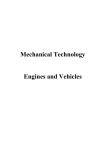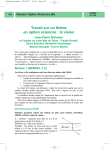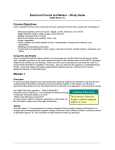Download Summary report of the Research Program on an Emissions and CO2
Transcript
Informal document No. GRPE-64-07 (64th GRPE, 5-8 June 2012, agenda item 4a) Summary report of the Research Program on an Emissions and CO2 Test Procedure for Heavy Duty Hybrids (HDH) Date 25 May 2012 Author(s) Henk Dekker – TNO Mobility Michael Planer -Vienna University of Technology Stefan Hausberger - Graz University of Technology Jonas Fredriksson - Chalmers University of Technology Copy no No. of copies Number of pages Number of appendices Sponsor Project name Project number 36 (incl. appendices) European Commission DG Enterprise and Industry Directorate D - Industrial Innovation and Mobility Industries Developing the Methodology for Certifying Heavy Duty Hybrids based on HILS 057.01451 Summary Report HDH Research Project - 25-05-2012 2 / 36 Summary The main goal of the project is to assess the Japanese HILS certification method as a basis for the development of an emissions and CO2 test procedure for Heavy Duty Hybrids (HDH), which should be worldwide established. The test procedure should be based on the HILS (Hardware-in-the-Loop Simulation) method. As a starting point the WHVC (World Harmonized Vehicle Cycle), the test cell environment, data evaluation procedures and emissions calculations specified in gtr (global technical regulation) No.4 under the 1998 Global Agreement have been used. The approach planned was to develop a procedure starting with a vehicle cycle (speed pattern) and by using a vehicle model, a driver model and models of motor/generator and energy storage and the real ECU hardware and software transforming the vehicle cycle into a specific engine cycle by using Hardware In the Loop simulation. This new engine cycle is then used for testing the pollutant emissions on the engine test bench in the same way as it is done for a conventional engine. The Japanese HILS procedure and the HILS open source model were evaluated and possible enhancements (e.g. more topologies, component library, temperature signals to include cold start tests) are proposed. In general the simulation model provides a good basis for a global regulation, but more work is needed before a worldwide test procedure can be drafted. The review of vehicle related data resulted in different options for the realisation of a World Heavy Duty Hybrid Cycle (WHDHC) which leads to power demand cycles at the power pack shaft which are similar to the test cycle for conventional engines (WHTC). The set of cycles comprise a vehicle speed cycle, a wheel hub power cycle and a power pack shaft cycle. An important issue is to agree on a method to determine how the full load curve for hybrid power packs has to be defined. The Japanese HILS simulation model verification process is a promising method for comparison but it has to be modified. Japanese tolerances can be used but have to be discussed in detail to be appropriate for a global technical regulation. The models to include non-electric hybrids have been developed based on models presented in the literature. The abstraction level of the new component models enables them to be run in real-time in a HILS setup. Furthermore, the models can be used, more or less, “plug & play” with the models of hybrid electric powertrain models. In general, the component test procedures from Kokujikan No. 281 can be used to provide data for the simulation models. The test procedures are common test procedures and it seems feasible to adapt them to a global regulation. The description in Kokujikan No. 281 of how each component/system should be tested and how the models should be validated appears applicable to the components of both electric and non-electric hybrids. It is not recommended to include PTO power demand in the test procedure for regulated pollutants since this would not be in line with the test procedure for conventional engines. PTO operation can be considered for the test procedure for CO2 emissions of the entire vehicle. Options are the use of a benefit factor according to US EPA 40 CFR 1037.525 or including PTOs in the simulation tool or a combination of both. Summary Report HDH Research Project - 25-05-2012 3 / 36 A method to calculate WHVC weighting/scaling factors to represent real world vehicle operation is developed. Also options to coordinate the HDH test procedure with CO2 test procedures for Heavy Duty Vehicles (HDV) have been elaborated. Information regarding the next steps which will include validation work using a SILS approach is provided. Summary Report HDH Research Project - 25-05-2012 4 / 36 Contents Summary .................................................................................................................. 2 1 Introduction .............................................................................................................. 5 2 Task 1: Investigation and modification, if applicable, of the HILS model and interface .................................................................................................................... 6 Task 1.1: Review of interface and software setup..................................................... 6 Task 1.2: Review of vehicle-related data ................................................................ 11 Task 1.3: Analysis of improvement and relevant gaps for a global regulation ........ 16 Task 1.4: Meetings with OEM’s and stakeholders .................................................. 17 Task 1.5: Analysis of necessary preparation work to run a HILS system ............... 17 2.1 2.2 2.3 2.4 2.5 3 3.1 3.2 3.3 4 4.1 Task 2: Investigation and modification, if applicable, of the HILS component testing ..................................................................................................................... 21 Task 2.1: Detailed review of the test procedure for obtaining HIL input parameter 21 Task 2.2: Analysis of improvements and relevant gaps concerning component testing ...................................................................................................................... 22 Task 2.3: Improvements for future technological development ............................... 22 4.4 4.5 Task 3: Extension of HILS to non-electrical hybrids ......................................... 23 Task 3.1: Detailed analysis on what non-electric hybrid systems/components to be included in procedure .............................................................................................. 23 Task 3.2: Development of HIL elements for non-electrical hybrid systems/components Modelling .............................................................................. 27 Task 3.3: Detailed review and development of component testing for parameters of non-electrical hybrid systems/components ............................................................. 28 Discussions.............................................................................................................. 28 Conclusions ............................................................................................................. 29 5 5.1 5.2 5.3 Task 4: Inclusion of PTO operation ..................................................................... 30 Task 4.1: Options to simulate PTO power demand................................................. 30 Task 4.2: Options to transfer different engine work into a benefit system .............. 30 Task 4.3: Collection of data for one vehicle mission profile .................................... 31 6 Task 5: Development of WHVC weighting/scaling factors to represent real world vehicle operation ........................................................................................ 32 Task 5.1: Analysis of typical profiles for vehicle speed and propulsion power ....... 32 Task 5.2: Elaboration of weighting factors for different parts of the WHVC ............ 32 Task 5.3: Elaboration of options to use the HILS method in the HDV CO2 test procedure................................................................................................................. 33 4.2 4.3 6.1 6.2 6.3 7 Outlook ................................................................................................................... 36 Summary Report HDH Research Project - 25-05-2012 1 5 / 36 Introduction This report is an interim report and serves as a summary of the work performed within the research program on an emissions and CO2 test procedure for Heavy Duty Hybrids (HDH). The HDH research program is executed by the Institute for Powertrains and Automotive Technology of the Vienna University of Technology, The Institute for Internal Combustion Engines and Thermodynamics of the Graz University of Technology and The Department of Signals and Systems of the Chalmers University of Technology. The project is sponsored by the European Commission, OICA, Sweden and the Swedish Energy Agency (SEA). The report is structured according to the tasks defined for the HDH research program: Task 1: Investigation and modification, if applicable, of the Japanese HILS model and interface including a proposal for a verification method w/o vehicle testing Task 2: Investigation and modification, if applicable, of the HILS component testing Task 3: Extension of HILS to non-electrical hybrids, which are currently not covered by the Japanese test procedure Task 4: Inclusion of PTO operation, which normally takes place outside the test cycle Task 5: Development of WHVC weighting/scaling factors to represent real world vehicle operation It was compiled from the contributions of the HDH project partners and the responsibility for the work remains with those partners. The full reports are/will be published separately and more details and references can be found in those reports. Task 1.1, Tasks 1.3-1.5 and Task 2 are the responsibility of IFA/TU Vienna, Task 3 of Chalmers and Task 1.2 and Tasks 4 and 5 of TUG. Summary Report HDH Research Project - 25-05-2012 6 / 36 2 Task 1: Investigation and modification, if applicable, of the HILS model and interface 2.1 Task 1.1: Review of interface and software setup 2.1.1 Japanese HILS certification For the Japanese HILS certification, five types of hybrid electric vehicles are considered (four parallel, one serial hybrid) within powertrain models. The five topologies and parameters (including battery type) are inspired by actual vehicles on the Japanese Market. The simulation model is realized with MATLAB® SIMULINK®, a well-established programming language, which is based on physical models and lookup tables. The model mainly consists of the powertrain and the interface model. The powertrain model is representative for combustion engine unit, motor/generator unit, energy storage unit and drive unit. The interface model is responsible for time dependent input values of the hybrid control unit. The purpose of the interface model is to convert physical quantities of ECU electric signals to fit on the open source model calculations, to generate dummy signals if necessary, to prevent vehicle fail and to convert ECU signals for calculations if needed. In addition, a driver model is used to create the necessary pedal position as an input to the ECU and the hybrid control unit. For the HILS verification, the test is separated in two steps. The first step is used for confirmation of the consistency between the HEV system and each model and the second step to confirm the quality of the vehicle model. Thereby the results of the simulation model are validated by available measurement data. If the performance is close enough to a previously validated system, the powertrain system is assumed to be valid and type-approval of the vehicle can be performed. If the powertrain performance differs from a previously validated system, the complete system needs to be validated against chassis dynamometer tests or power pack tests. Generally the Japanese HILS certification is a very promising method for certification of heavy duty hybrids. In order to set up a global regulation by using the Japanese method as a basis, modifications/enhancements have to be done. The Japanese HILS-System consists of real hardware in combination with software components. Figure 1 shows the schematic topology of the Japanese simulation model. Summary Report HDH Research Project - 25-05-2012 7 / 36 Figure 1: Schematic Model Topology The whole system is based on a so called Hardware in the Loop simulation. In order to close the open loop of System components which are represented by a software model, real hardware is used. Within The Japanese HILS concept only the ECU is represented by real hardware. All other components are recognised by software model. The present simulation model consists of two main parts: Interface Model Powertrain Model 2.1.1.1 Interface Model The Interface Model is mainly responsible for the data shifting between real hardware and simulated hardware (software) components. A part of its tasks is to provide time dependant values as inputs or outputs. These values are allocated by external Hardware, in case of certification a real hardware ECU. In order to do some pre checks for simulation possibility of using software modelled ECU is also given. Therefore the so called “HILS/SILS-switch” is used and responsible for defining whether real hardware or software should close the loop for simulation. In order to make an assessment of the Japanese HILS certification method, a simplified software ECU is used. The interface model also serves the purpose of converting physical quantities of ECU electric signals in order to feed the open source model calculations. In order to prevent vehicle fail, dummy data or signals are generated within the interface model. IFA didn’t have access to a real interface model due to confidentiality. Therefore the assessment of interface model is only done on open source model. Within the Japanese open source model the SILS option is used. This makes IFA’s investigations without using real hardware possible. Therefore assessment is done on available data. Generally Japanese hardware and software like presented is a promising configuration basis in order to a global regulation method. Summary Report HDH Research Project - 25-05-2012 2.1.1.2 8 / 36 Powertrain Model The second main part is the powertrain model and includes all remaining powertrain components. In Japan, five different types of powertrains, four parallel and one serial soncept, exist and each one has its own model (Figure 2). Figure 2: Hybrid Vehicles in Japanese Market The investigated open source model represents a heavy duty vehicle with parallel hybrid topology and combines the four main components: Combustion Engine Unit Motor/Generator Unit Energy Storage Unit Drive Unit As a part of the investigations, the Japanese Automobile Research Institute (JARI) did a practical demonstration of the HILS measurement method in Karima, Tsukuba, Ibaraki. JARI uses CRAMAS hardware from Fujitsu Ten in combination with SimAct software from Ono Sokki to run the system (Figure 3). CRAMAS stands for “ComputeR Aided Multi-Analyses System” and represents the developed HIL simulator for the Electronic Control Unit (ECU). For software modelling MATLAB® SIMULINK® program language is used as for setting up the model. CRAMAS hardware is able to handle several different signal types in order to set up an interaction between hardware and software. Data shifting between the software model and the hardware ECU can be done in real time. 9 / 36 Summary Report HDH Research Project - 25-05-2012 Figure 3: HILS-Hardware The HILS method itself does not restrict the behaviour of DSP (Digital Signal Processor, hardware for HILS). However, it is necessary to verify whether the DSP is an appropriate hardware for the type approval test of HEV. Therefore, a testing method to verify the calculation performance within the DSP using the SILS model was developed. In this test, the calculation results by SILS of basic system are regarded as standard, and compared the results of DSP to be used. The calculation performance of the DSP hardware is sufficient for the type approval test and will therefore be checked. In general, HILS hardware at least has to be able to handle with “AD/IO, PULSE, LVDS, LAN and CAN” -signal types. Sufficient for constructing the interface between the HILS hardware and the actual ECU are a certain number of provided channels. Those channels have to be checked and calibrated in order to provide high accuracy. Real time capability must be ensured. This can be done by using the aforementioned SILS opportunity in order to test the DSP and its hardware components. The assessment of the software of the demonstrated HILS system is provided in the IFA final report. IFA presented this Japanese HILS approach to manufacturers and OEMs to get their opinion. According to the OEMs, the following signals also have to be recognized within the HILS method and have to be added to the presently used signal list in the appendix of the IFA final report: Table 1: Manufacturer required signals Model SignalSpecification Designation RESS Temperature Temperature data of power electronics Engine/Generator Temperature Temperature data of power electronics 10 / 36 Summary Report HDH Research Project - 25-05-2012 Combustion Engine Temperature Exhaust temperature (at multiple locations) Coolant temperature Oil temperature Intake temperature Environment Temperature Air temperature The HILS hardware has to be able to handle the transfer of these mentioned signals between software model and ECU. Possible signal types, which are not covered at the moment and not mentioned by manufacturers during meetings, may have to be added in future. Therefore the used system must provide the possibility of expansion with low effort. 2.1.2 HILS open source model In order to make an assessment to the simulation model without using real hardware, JARI offered a so called open source model which can be operated in completely with software. It is a kind of SILS-model where the ECU is represented by a simplified predetermined control algorithm. In general the open source model is divided into several blocks, which makes it easier to set up such kind of comprehensive simulations. Therefore all functions, maps or data which represent one compound of the powertrain are combined to an extra block called sub-model. This kind of sub-model programming provides good overview of complete simulation model and prevents from losing track. Another advantage of using submodels is the ability to exchange full blocks, if components should be replaced. The Japanese open source HILS model is realised with Simulink®, a wellestablished programming language, and doesn’t have to be changed in future. The model depth of component characterisation depends on the given tolerances. If the results are not accurate enough, the sub-model has to be enhanced by updating either the used specific functions and differential equations or the used characteristic maps. For detailed information about providing characteristic maps, please see Kokujikan No. 281. Generally the simulation model (assessment based on open source model) provides a good basis for a global regulation, but before it can be used in a worldwide test procedure additional work has to be done and this will be outlined in section 2.3. Summary Report HDH Research Project - 25-05-2012 2.2 11 / 36 Task 1.2: Review of vehicle-related data Regulated pollutant emissions of conventional heavy duty engines for certification are being determined on an engine test bed using the world-harmonized test cycles WHSC and WHTC. The WHTC test cycle depends on the shape of the full load curve of the engine and leads to load points of the engine both in part and full load (Figure 4). Figure 4: WHTC load points (exemplary for one particular engine) In the original Japanese HILS (Kokujikan No. 281) approach a vehicle speed cycle over time is used as input. However, the resulting engine load cycle will depend on the vehicle parameters when a vehicle speed cycle is used as input. Therefore especially engines of vehicles with high power to mass ratio are operated in part load only and the engine would never be run at load points with high power or even full load for pollutant emission certification purposes. As a result, measured emissions for conventional engines and heavy duty hybrids might not be comparable. Figure 5 shows these facts for two vehicles according to the Japanese standard vehicle specification for the exhaust gas test procedure for heavy duty vehicles. These two vehicles driving the WHVC were simulated with the software PHEM. The same engine data was used for both vehicles, while the vehicle data was set according to Kokujikan No. 281. Summary Report HDH Research Project - 25-05-2012 Figure 5: 12 / 36 Left: Japanese T4 vehicle (mass 8,450kg, 240kW rated power) in WHVC Right: Japanese T7 vehicle (mass 24,662kg, 240kW rated power) in WHVC A new test cycle called WHDHC (world heavy duty hybrid cycle) was developed, which takes the shape of the hybrid power pack full load curve into account and thus leads to similar load points for hybrid power packs as the WHTC for conventional engines. 2.2.1 Generation of the WHDHC In order to get similar load cycles for heavy duty hybrid power packs and conventional heavy duty combustion engines, a new method for generating the WHDHC was developed. This new test cycle depends only on the full load curve of the power pack system and not on vehicle related data. This makes the type approval of a hybrid power pack generally more comparable to conventional combustion engines. Based on the hybrid power pack full load curve, the load cycle is calculated according to the WHTC method. So far, this step is not different from the procedure for conventional engines. From this WHTC load cycle, a fixed fraction for vehicle drivetrain losses1 is subtracted to get the power cycle at the wheel hubs. To allow for charging of a hybrid vehicle’s RESS (rechargeable energy storage system) during phases of deceleration, a corresponding negative power course for mechanical braking is added in the existing motoring phases of the WHTC2. Figure 6 shows the resulting differences between WHTC and WHDHC. 1 Efficiencies as used in the actual Japanese HILS model (Kokujikan No. 281). As a nature of an engine test cycle the WHTC has negative power only down to the engines motoring curve. 2 Summary Report HDH Research Project - 25-05-2012 Figure 6: 2.2.2 13 / 36 Power course of WHTC vs. WHDHC (exemplary for one particular vehicle) Negative power for the WHDHC The main task was to develop a normalized negative power (mechanical braking and engine motoring) course, which is representative for all vehicle categories. Analysis of real world driving data for several city buses in Vienna showed that the corresponding negative power cycle for the WHDHC is not dependent on the shape of the full load curve but can be normalized with the vehicle’s rated power. For this task 13 generic heavy duty vehicles according to HBEFA 3.2 were simulated in the WHVC with the software PHEM and the resulting absolute values for negative power were normalized by the vehicle’s rated power. From the results for these 13 generic heavy duty vehicles an average normalized negative power course was calculated (“P_neg_norm_average” in Figure 7 representing the “average normalized negative power cycle”). Another issue was the dependency of the negative power on the vehicle category. Due to less frontal area per kW rated power and advanced aerodynamic measures, long haulage vehicles have lower air resistance per kW rated power. Therefore, more normalized mechanical braking is necessary for large, long haulage HDV than for smaller trucks (Figure 7, right corner). To account for the influence of vehicle categories, a correction factor for the average normalized negative power cycle was developed by calculating the line of best fit for the data of all analysed vehicles. The average normalized negative power cycle shown in Figure 7 has to be multiplied by this correction factor and by the vehicle’s rated power to get the absolute negative power cycle for one particular vehicle in the WHDHC. Pnegative-WHDHC = P_neg_norm_average * P rated power pack * P-Rated-Factor With: P-Rated-Factor = 0.00367 * P rated power pack Certainly these two equations can be merged to have a very simple and compact application. Summary Report HDH Research Project - 25-05-2012 Figure 7: 14 / 36 Average normalized negative power (P/Prated) in the WHVC vs. normalized negative power in the WHTC A Microsoft Excel tool was developed to automatically calculate the complete WHDHC test cycle as described in chapters 2.2.1 and 2.2.2 for a given full load curve of a particular hybrid power pack. 2.2.3 Different options for the WHDHC There are different options to feed the WHDHC into a HILS model: B-1) As power cycle at the wheel hubs together with the WHVC as speed cycle. The existing HILS model needs then an adapted driver model to control the torque at the wheel hub instead of the vehicle speed. B-2) As power cycle at the power pack shaft. The speed signal can be either the original WHTC engine speed or the rotational speed computed from the WHVC vehicle speed via the transmission ratios. The existing driver model in HILS also needs to be adapted with this version. B-3) The WHVC as vehicle speed cycle with individually calculated road gradient cycle, vehicle mass, air resistance and driving resistance data to create the same power cycle as the WHDHC at the wheel hub. Thus vehicle parameters and road gradient are calculated iteratively from the full load curve of the power pack. Option B-3) is not implemented in the Excel tool yet. An adaptation of the driver model would not be necessary for B-3) but the road gradient needs then to be considered in the set of vehicle longitudinal equations. Option B-2) presents a simple method, since there is no gear box model needed. However, for some hybrid systems B-2) may not be applicable and for some hybrid vehicles the engine speed cycle from the WHTC may result in an unrealistic load cycle. This issue needs further validation work in the next phase of the project. For Option B-1) the load cycle simulated in HILS at the power pack depends on the gear box model. If only generic gear box models with fixed generic efficiencies for direct and indirect gears are used, the result should be very close to B-2) in all applications. It is not clear yet, if some future HDH would involve modelling of complex automatic or automatized gear boxes in a HILS system for realistic results. In this case option B-2) may be preferable. Option B-3) would be necessary for hybrid systems where different axles are driven by different engines and/or electric motors. Figure 8 shows the options B-1) and B-2). Both are ready to be used also on power pack test stands. All three options should give similar load cycles at the shaft of the power pack and all three options will not depend on vehicle specific data but only on Summary Report HDH Research Project - 25-05-2012 15 / 36 the full load curve of the power pack. It is suggested to implement all three options in the HILS simulator to enable a comparison during the development phase of the HILS method. Maybe also in the final HILS version all options can be offered and the user selects the best option, which may depend on the HDH system under consideration. Figure 8: Different options to feed WHDHC into HILS model For the verification of the HILS simulator set up the course of the torque at the wheel hub from on board measurements of the HDH can be used as input. 2.2.4 Open issues and necessary adaptions in the Japanese HILS method The normalization of the rpm for heavy duty hybrid power packs needs to be further validated in the next phase of the project and adapted when necessary. The issue here is that for conventional engines the rpm values are normalized between idle speed being 0 and rated speed being 1. Since idle speed can be 0 rpm for hybrid power packs the de-normalisation of given load cycles results in slightly lower speeds and thus slightly lower power for hybrid power packs. Further investigation is necessary to determine whether these coherences pose a problem for the comparability of the WHTC method for conventional engines and the WHDHC method for hybrid power packs. Since the WHDHC method is based on the full load curve of a hybrid power pack, a generally agreed method to determine the full load curve for hybrid power packs has to be defined. At the moment the summation of the full load curve of the engine and of the electric motors seems to be a reasonable approach where the short term maximum power of the motors shall be applied. Summary Report HDH Research Project - 25-05-2012 2.3 16 / 36 Task 1.3: Analysis of improvement and relevant gaps for a global regulation The following model and method enhancements were identified: Powertrain concepts: According to the Japanese HILS certification method, there are only five different types of powertrains available. In order to include more types of powertrains, including non electric hybrid concepts, have to be implemented. Component modelling: In order to set up a hybrid powertrain model, numerical solving of specific differential equations and maps are used within the Japanese method for representing each component. In order to a global regulation future components have to be added. A promising concept will be a component library. This makes it possible to choose the right component out of a list and only characteristic data have to be inserted as maps. Certification with hot and cold start: The Japanese HILS certification is only done in warm condition. Due to the European certification, cold start also has to be recognised. Durability: The Japanese HILS model only recognises “healthy” components. This means that there is no durability of the components recognised within the simulation model. The implementation of aging models has therefore to be discussed. Thermal modelling: The hybrid electric powertrain is the combination of two propulsion systems in order to achieve either better fuel economy than a conventional vehicle, or better performance. In the present case a conventional internal combustion engine (ICE) propulsion system cooperates with an electric propulsion system. In order to use right operation strategy (pure electric driving, load point shifting …) the hybrid ECU needs specific data from certain components. According to the OEMs temperature signals have to be provided and recognised within the simulation model in order to feed the ECU with data. The Japanese HILS model does not cover temperature signals and should therefore be modified. (ECU needed temperature signals are shown in Table 1 in section 2.1.1.2). Auxiliaries: The hybrid powertrain provides the possibility of using some auxiliaries more efficiently by electrification of some components or even electrified control. Due to actual certification methods, no auxiliaries are recognised for emission certification, but for a global regulation a discussion on this topic may be needed. According to IFA/TU Vienna and OEMs more powertrain topologies have to be implemented. Therefore the model, including verification, has to be improved. Any powertrain simulation model should be allowed. A simplification of the modelling process would be the availability of an official component library in which the well suited Japanese sub-models are the basis. According to manufacturers, new hybrid concepts including non-electrical concepts are planned. These concepts have to be Summary Report HDH Research Project - 25-05-2012 17 / 36 implemented within the simulation model. In addition temperature signals have to be provided within the simulation model. This includes an increase of effort in component test procedures. In cases of too high effort an “Extended HILS Method”, which is an expansion of the Japanese HILS method, can be used. In summary, the Japanese model is evaluated to be a good basis, but needs to be refined for a global regulation. Therefore further investigation, is needed and will be done in the following Verification Test Program 1 (May 2012) according to the GRPE HDH road map. 2.4 Task 1.4: Meetings with OEM’s and stakeholders 2.5 Task 1.5: Analysis of necessary preparation work to run a HILS system Before a simulation model is used for certification, it has to be verified to provide the reproducibility for the behaviour of the actual vehicle (chassis dynamometer) or system (system test bench). Therefore the following two verifications methods were used. 1. Verification of correlation within a short-period vehicle operation Within this first verification test, the first 120 seconds of Japanese JE05 test cycle are taken for a small trip. Within this short period, start-acceleration-gearshiftdeceleration-stop operations are recognised. Figure 9: 1st Step of HILS Verification test This verification clarifies whether the model reproduces the behaviour of each hybrid segment by using the actual accelerating/braking pedal signals as input into HILS. The correlation between the HILS calculation results and the actual vehicle (or system) operation are examined for the following items. 1) Vehicle speed or engine rpm 2) Torque and power of the electric motor 3) Torque and power of the engine 4) Power of RESS Summary Report HDH Research Project - 25-05-2012 18 / 36 Good correlation is demonstrated by confirmation of tolerances. The table below shows an example of maximum allowed tolerances within the short-term verification test. Table 2: Table of tolerances for 1st Step of HILS Verification Test Figure 10: Comparison for 1st Step of HILS Verification Test Correlation coefficients for each variable (e.g. MG Torque or RESS power) are calculated and have to be larger than the specific tolerance value. If these conditions are fulfilled, next verification step will be done. Otherwise the simulation model has to be improved. 2. Verification of correlation for the load and fuel efficiency of whole test cycle In order to check whether the HILS calculation reproduces the actual vehicle (or system) throughout the long-period operation cycle, total engine work and fuel consumption including several patterns of acceleration, deceleration are verified. Summary Report HDH Research Project - 25-05-2012 19 / 36 Figure 11: 2nd Step of HILS Verification Test If these aforementioned verifications steps are passed and results are within tolerances (Table 3), the simulation model is used for an entire HILS run. Table 3: Table of tolerances for 2nd Step of HILS Verification Test Figure 12: Comparison for 2nd Step of HILS Verification Test In other words, the simulation model has to fulfil a verification test which is separated in two steps in order to be used for certification. The first step is used to confirm the accurate behaviour of each hybrid segment. Therefore vehicle speed or engine rpm, torque and power of the electric motor, torque and power of the engine and power of RESS are compared to those of real measured vehicle data. To avoid a cumulative error, comparison is done for a short period of the Japanese speed cycle. Summary Report HDH Research Project - 25-05-2012 20 / 36 If the results are within tolerances, the second test (long term verification test) is done by comparison of simulated data with real measured data. If all results are within tolerances, the simulation model is suitable for HILS certification run. This Japanese simulation model verification process is a promising method for comparison but has to be modified slightly in a first step. Therefore the driving cycle has to be changed to a specific and later to a worldwide cycle. Japanese tolerances can be used but have to be discussed in detail to be appropriate for a global technical regulation. Summary Report HDH Research Project - 25-05-2012 21 / 36 3 Task 2: Investigation and modification, if applicable, of the HILS component testing 3.1 Task 2.1: Detailed review of the test procedure for obtaining HIL input parameter The components of the heavy duty hybrid powertrain are represented by physical models (numerical solving of differential equations) and lookup tables within the Japanese HILS simulation model. In order to feed physical models with component specific data, special test procedures are used. These component characteristic data are combined to so called maps, which are used in the software models. One of the specific test procedures is shown in Figure 13. Figure 13: Test Procedure for Fuel Consumption Rate of Heavy-Duty Hybrid Electric Vehicles The exact component test procedure for HILS certification can be found in the Japanese regulation. Within this testing procedure each component which is recognised within the simulation model, has to run through specific tests in order to provide characteristic data. In general, the used component test procedures are well defined in order to provide data for simulation model. The aforementioned test procedures are common test procedures and it seems feasible to adapt them to a global regulation. Summary Report HDH Research Project - 25-05-2012 22 / 36 The simulation data have to be sufficiently accurate in order to fulfil the fixed tolerances. Due to future components, like non electric hybrids, new test procedures have to be defined. In other words, any powertrain simulation model is allowed, as long as the verification test is passed. If the verification test cannot be passed, obviously the component simulation model, including its component test procedures, has to be improved. 3.2 Task 2.2: Analysis of improvements and relevant gaps concerning component testing As already mentioned, additional temperature signals have to be provided within the simulation model. The testing effort in order to provide specific data for components is dependent on the need of accuracy for these signals. If there is a demand of high accuracy on e.g. the combustion engine temperature data signals, a high testing effort is expected. 3.3 Task 2.3: Improvements for future technological development In cases of too high testing effort the IFA/TU Vienna suggestion is to use an “Extended HILS” method. This suggestion is an expansion of the Japanese HILS method. The Extended HILS method uses the advantages of the “Hardware in the Loop System” by recognising another real hardware component, in addition to the ECU. This suggestion will be described in more detail in the IFA final report. Summary Report HDH Research Project - 25-05-2012 23 / 36 4 Task 3: Extension of HILS to non-electrical hybrids 4.1 Task 3.1: Detailed analysis on what non-electric hybrid systems/components to be included in procedure In this section, an analysis on what kind of non-electric hybrid systems / components that are available or can be foreseen in the future on the market, will be presented. A hybrid vehicle is a vehicle that has two or more ways to propel the vehicle. A hybrid system needs a secondary energy storage and a secondary energy converter that can propel the vehicle. In a hybrid electric vehicle, the conventional fuel tank and internal combustion engine is complemented with an electric energy storage system, like a battery or a super capacitor, and an electric machine to propel the vehicle. There are several ways to store energy in a non-electric way. Kinetic energy can be stored in a flywheel. Potential energy can be stored in a spring or in an accumulator. From a vehicle point of view, storing energy in a spring is not such a good way since it requires a very large spring, but using a flywheel or an accumulator are technical viable solutions. Today, there are two specific alternatives on the market for hybrid vehicles to store non-electric energy, namely hydraulic systems and/or flywheel systems. Therefore these two different ways are identified as the most likely to incorporate in a simulation based method. The operating principle for a pneumatic system is very similar to the operating principle of a hydraulic system, so pneumatic systems are also covered by looking at hydraulic systems. The second important part of a hybrid system is the energy converter. This is the part that converts the stored energy into mechanical, kinetic energy for propelling the vehicle. It is, of course, preferable when the same component can be used for converting mechanical kinetic energy to energy that can be stored in the energy storage system, i.e. the reverse operation. For a flywheel system, either the kinetic energy is transferred directly via a mechanical transmission, or transferred via an electrical transmission. An electrical transmission requires conversion of kinetic energy to electric energy and back to kinetic energy, and is usually done using an electric generator/motor configuration. For hydraulic and pneumatic systems, the potential energy needs to be converted to kinetic energy, this is usually done using a hydraulic (pneumatic) motor. In reverse operation, the motor is called a hydraulic (pneumatic) pump. 4.1.1 Topologies. The components in a hybrid vehicle can be arranged in several different ways. The way the components are arranged are often referred to as topology or vehicle topology. For hybrid electric vehicles three different topologies are usually used, series, parallel and split. In the series powertrain topology, there is no mechanical connection between the combustion engine and the propelling wheels, see Figure 14. The propulsion is made by the electric motor and the combustion engine is primarily used to assure that there is enough energy in the energy storage, the battery or the super capacitor. Summary Report HDH Research Project - 25-05-2012 24 / 36 Figure 14 Series powertrain topology. ICE - Internal Combustion Engine, G - Generator, B/SC - Battery or Super Capacitor, M - Motor. Figure 15 Parallel powertrain topology, post-transmission. ICE - Internal Combustion Engine, GB - Gearbox, B/SC - Battery or Super Capacitor, M/G - Motor and Generator. Figure 16 Parallel powertrain topology, pre-transmission. ICE - Internal Combustion Engine, GB - Gearbox, B/SC - Battery or Super Capacitor, M/G - Motor and Generator. In the parallel powertrain topology, the vehicle can be propelled by both the combustion engine and the electric motor, see Figure 15 and Figure 16. The energy for propulsion can be ”added” together before (pre-) or after (post-) the transmission, the gearbox. The split powertrain topology is more or less a combination of the series topology and the post-transmission parallel topology. It is sometimes referred to as seriesparallel powertrain topology. In Kokujikan No. 281, at the moment, only series and parallel powertrain topologies are considered. 4.1.2 Flywheel system. A flywheel hybrid system consists, as mentioned earlier, of a flywheel energy storage and a transmission, mechanical or electrical. Summary Report HDH Research Project - 25-05-2012 Figure 17 Flywheel hybrid system. ICE - Internal Combustion Engine, GB - Gearbox, FW - Flywheel. Figure 18 Flywheel hybrid system. ICE - Internal Combustion Engine, G - Generator, FW - Flywheel, M - Motor. 25 / 36 For a flywheel system with a mechanical transmission, often a Continuously Variable Transmission (CVT) is used. Such a system can be categorized as either a series topology or a parallel topology, depending on how the flywheel system is controlled. Schematically, it can be visualized as shown in Figure 17. Such solutions have been applied to several different vehicle categories, from Formula 1 cars to city buses. An alternative approach is to connect the flywheel to an electric machine, the device then works as a ”mechanical battery”. This ”mechanical battery” can then be used in the same way as a normal battery in a hybrid electric vehicle. It is typically used in a series topology, see Figure 18. 4.1.3 Hydraulic/Pneumatic system. The most common non-electric hybrid vehicle combination is to use a hydraulic system. Numerous examples of this type of solution exist, for example Eaton’s Hydraulic Launch Assist, Bosch Rexroth’s HRB system, Parker’s Runwise system and Poclain’s ADDIDRIVE Assist. Several of these systems are available on the market today. All of these systems can be categorized into a series or a parallel topology, see Figure 19 and Figure 20. There are also variants that can be categorized as a split hybrid topology. Pneumatic hybrid systems work in the same way and can be categorized in the same way as hydraulic hybrid powertrain systems. In the literature, there exists an alternative pneumatic solution, where the combustion engine is used as pump/motor, see Figure 21. Also this type of system fits well into the parallel (pretransmission) topology. See for the literature references the final report of Task 3. Summary Report HDH Research Project - 25-05-2012 Figure 19 Parallel hydraulic powertrain topology. ICE - Internal Combustion Engine, GB - Gearbox, Acc - Accumulator, P/M - Pump and Motor, Res - Reservoir. Figure 20 Series hydraulic powertrain topology. ICE - Internal Combustion Engine, Acc - Accumulator, P/M - Pump and Motor, Res - Reservoir. Figure 21 Pneumatic hybrid engine. 26 / 36 Summary Report HDH Research Project - 25-05-2012 27 / 36 4.1.4 Summary. Electric hybrid powertrains are usually divided into three different categories, series, parallel and split powertrain topologies. Non-electric hybrid powertrain topologies (concepts) fit well into the same categories as for electric hybrid powertrains. Of the identified different powertrain concepts that are available or can be foreseen in the future on the market, the following non-electric powertrains are considered interesting: CVT and flywheel, motor/generator and flywheel and pump/motor and accumulator (hydraulic and pneumatic). 4.2 Task 3.2: Development of HIL elements for non-electrical hybrid systems/components Modelling In this section the component models that needed to be developed will be introduced. The models are developed using a similar abstraction level as used in the Japanese HILS method, but cover the additional set of components, namely non-electric powertrain components. The modelling philosophy that is used in Kokujikan No. 281 is called forwarding, which means that the powertrain is described by models represented by differential equations. This makes it possible to take dynamic effects into account. Furthermore, closed-loop control can be used to control the components or the complete system, which is a necessity to be able to do HIL simulations. 4.2.1 Component modelling. From the technology overview and selection of scope made in the previous section the following models needed to be developed: Flywheel Continuously Variable Transmission (CVT) Hydraulic/Pneumatic Accumulator Hydraulic/Pneumatic Pump/Motor The final report of Task 3 will present examples of the models for characterising the components. It should be noted that the important part is the input- output structure, not the model equations. The structure assures that the models can easily be connected together to form a powertrain. The model equations for each component/system can be any type of mathematical description of the component as long as it represents a real component/system, this is regulated in, for example, Kokujikan No. 281. 4.2.2 Summary. The models have been developed based on models presented in the literature. They have a similar abstraction level as the models used in the Kokujikan No. 281, meaning that the new components can be run in real-time in a HILS setup. Furthermore, the models can be used, more or less, “plug & play” with models of hybrid electric powertrain models, i.e. it is easy to change to a non-electric powertrain configuration from an electric powertrain configuration by just changing the different components. Summary Report HDH Research Project - 25-05-2012 4.3 28 / 36 Task 3.3: Detailed review and development of component testing for parameters of non-electrical hybrid systems/components It is concluded that the methods described in Kokujikan No. 281, how each component/system should be tested and how the models should be validated, can be transferred to non-electrical hybrids. 4.4 Discussions Kokujikan No. 281 is, as stated before, a method developed for emission certification of hybrid electric vehicles. To adapt the method to non-electric hybrid vehicles requires some modifications, for example to specify the control system interface to and develop methods for obtaining model parameters. 4.4.1 Topologies. From the analysis of non-electric hybrid powertrains, it can be concluded that nonelectric hybrid powertrain topologies (concepts) fit well into the same categories as those existing for electric hybrid powertrains. This means that, from this point of view, no major modifications to the approach of Kokujikan No. 281 is required. This is also verified by a simple simulation study. 4.4.2 Model structures and mathematical models. The mathematical models developed for non-electric hybrids are examples of models that can be used for HILS. The important part of the models is not the equations but the input-output structure as mentioned earlier. The proposed model structure is similar to the model structure in Kokujikan No. 281, so nonelectric hybrid powertrains can be developed using “plug & play”. Furthermore, the simulation study revealed that the proposed models worked properly. 4.4.3 Test methods for data to non-electric component models. It should be noted that an important part of a HILS method is to specify which and how component parameters are to be determined. In this work, no such attempts have been made. The models proposed are based on models found in the literature, the models’ parameters have a physical meaning, so it should be possible to determine all parameters from measurements or from data sheets. This has also been verified through analysis of simulation tools, like Hopsan and Dymola and through discussions with experts in the area. The final specification on how to determine component parameters is left as future work. 4.4.4 Control system interface. To control the HILS model, whether it is an electric or non-electric hybrid vehicle, a controller is to be connected to the model. It is almost impossible to determine an interface suitable for all OEM control systems, instead a generic interface to the HILS model is defined. In Kokujikan No. 281 the signals needed to control the HILS model are listed and specified. The list is complemented with the control signals needed for the non-electric powertrain components. The control signal interface proposed is presented in Appendix B of the final report of Task 3. Summary Report HDH Research Project - 25-05-2012 4.5 29 / 36 Conclusions In Japan a simulation based method for emission and fuel consumption certification of heavy-duty hybrid electric vehicles has been developed. This work studies the method for certification, Kokujikan No. 281, and how it can be modified for other types of hybrid vehicles, non-electric hybrid vehicles. The investigation shows that non-electric hybrid powertrains can be viewed in the same framework as electric hybrids. This means that most of the method and the requirements put on the method and the models can be used also for non-electric powertrains, i.e. non-electric hybrid vehicles can be included into the method rather easily. Summary Report HDH Research Project - 25-05-2012 5 Task 4: Inclusion of PTO operation 5.1 Task 4.1: Options to simulate PTO power demand 5.2 Task 4.2: Options to transfer different engine work into a benefit system 30 / 36 Hybrid vehicles are in the position to deliver power demands from PTOs partly from recuperated energy and/or from engine operation in more favourable engine operating points. Therefore PTO power demand could be delivered by a HD Hybrid vehicle at lower specific emissions than by a conventional vehicle. Options to take this advantage into consideration have been analysed here. The analysis leads to the following conclusions: 1) PTO operation adds a rather small proportion of average engine power over a driving cycle. Simulation runs based on EURO V engine emission maps in the WHVC with a constant additional engine load to simulate PTO operation did not show significant changes in the resulting emissions in [g/kWh]. This result meets the expectations. 2) PTO power demand is not included in WHTC test cycle for conventional engines. Thus adding a power demand for PTO operation only to the WHDHC but not to the WHTC would not be a benefit for hybrid systems. 3) Changing the WHTC to include also PTO power demand is possible but the small influence on the resulting [g/kWh] seems not to justify the effort to change the established cycle. 4) Alternatively to an adaptation of the WHTC also the WHDHC could be adapted by just reducing the load cycle by a constant value to have then room to simulate an additional PTO power demand. Since the WHTC has zero load at idling, a “PTO reduction factor” cannot be applied where it should be applied for many HDV categories, i.e. at idling. Otherwise the basic simulation “without PTO” would run idling conditions at negative engine loads and would also not reach full load at other driving conditions. 5) As a final solution PTO benefits could be based on a “PTObenefit-factor”. The HILS model could be run with and without PTO power demand. To obtain the benefit-factor the same simulations would be necessary for the conventional power train system. The benefit factor could then be the ratio of engine work from the HDH power pack to the engine work from the conventional system. Such a correction factor could be applied to the measured emissions3. Following the approach from US EPA 40 CFR 1037.525 for CO2 emissions this benefit factor could also be obtained by measurements instead of simulation. However, since it is unlikely, that the regulated pollutant emissions in [g/kWh] change proportionally to the engine work, this method will not lead to founded results for NOx, PM, PN, HC and CO but just to incentives to optimise the PTO connection to the hybrid system. As a result of the investigations it is not recommended to consider PTO in the HILS method for the calculation of the engine test cycle for the regulated pollutants. The situation is different for CO2. For energy consumption and CO2 small improvements are already relevant and in addition the test methods for CO2 from HDV are still under development and may be adapted more easily than the WHTC. 3 [g/kWh]corr = [g/kWh]measured * PTObenefit factor Summary Report HDH Research Project - 25-05-2012 31 / 36 Assuming that the HILS simulator will be applied also in context with the HDV-CO2 test procedure to simulate the fuel consumption (or just the engine power and rpm course) as outlined in chapter 6.3, the test cycle for conventional and for hybrid vehicles could include a power demand for PTO for the vehicle classes where PTO operation is relevant. The PTO-cycle can be defined as course over time and distance together with the vehicle speed and the road gradient as outlined in the actual suggestion for a European HDC-CO2 test procedure. Vehicle classes with relevant PTO operation are e.g.: Garbage trucks (compression work) City bus (air conditioning system) Municipal utility (e.g. road sweepers) Construction (e.g. work of a crane) 5.3 Task 4.3: Collection of data for one vehicle mission profile It was agreed in the HDH group that as an example a PTO power demand cycle for the air conditioning (AC) cycle of a city bus shall be elaborated. A test cycle for hydraulic power take off is already available from US EPA. To elaborate the AC cycle, a simulation tool developed in an earlier project for DGENTR was used to assess the mechanical power demand from the AC system as function of ambient temperature and humidity. The influence of the glazing quality could be considered by a correction factor. The data simulated was supplemented by measurements on a city bus in Graz which has an electric driven AC system. For which ambient conditions of temperature and humidity the cycle shall be finally defined needs further discussion and coordination with the HDV-CO2 test procedures. The application of the PTO cycle for HDV AC systems would be in the simulation of the vehicle specific CO2/km value 4. The HDV-CO2-simulator could provide the power cycle at the wheel hubs together with the target power demand of the AC system for the vehicle specific input data in the corresponding test cycle. The HILS simulator then provides the resulting trajectories for engine power and rpm, which then can be used in the HDV-CO2 simulator to interpolate the fuel consumption from the engine fuel map (see chapter 6.3). 4 Or g/ton-km or g/m3-km,… Summary Report HDH Research Project - 25-05-2012 32 / 36 6 Task 5: Development of WHVC weighting/scaling factors to represent real world vehicle operation 6.1 Task 5.1: Analysis of typical profiles for vehicle speed and propulsion power Driving conditions are quite different between different vehicle classes and reach from mainly urban driving (e.g. city bus) to mainly highway driving (e.g. semitrailers). Thus the entire WHVC is representative for an average HDV but not for the single vehicle classes. To be in the position to provide vehicle class specific results, weighting factors are elaborated which adapt results from the WHVC to single HDV classes. The European draft HDV-CO2 test procedure defines a matrix of HDV classes and corresponding representative real world driving cycles. 6.2 Task 5.2: Elaboration of weighting factors for different parts of the WHVC The software PHEM is used to calculate power demand, engine speed, energy consumption, emissions, vehicle speed and derivatives for the WHVC and for the CO2-test cycle representative for a HDV class. Then the WHVC-weighting factors are gained iteratively to reach the lowest deviation in the results between the weighted WHVC and the representative driving cycle. The resulting WHVCweighting factors are then valid for the considered vehicle category. The WHVC is split into three different sub-cycles (urban, road, motorway) and for each of these sub-cycles the weighting factor is varied between 0 and 1 while the sum of the three weighting factors has to be 1.0. The fundamental equations and boundary conditions for the developed method are shown in Figure 22. Figure 22: Method for calculating the WHVC-weighting factors Summary Report HDH Research Project - 25-05-2012 33 / 36 The method for the calculation of WHVC weighting factors was applied for city buses yet (Figure 23). Unsurprisingly, for the considered city bus cycle the calculated weighting factors are 100% for the WHVC urban sub-cycle, the two remaining sub-cycles are weighted with 0%. Figure 23: Calculation of WHVC weighting factors for city bus cycle For the validation also a model of a hybrid city bus will be run in PHEM over the WHVC and in the representative CO2 test cycle. This model is just under preparation and results will be shown in the final TUG report. Since the representative driving cycles for the European HDV-CO2 test procedure are still under development, this task was only carried out for the already existing city bus cycle. As soon as the remaining cycles are available (expected until end of 2012), this task will be finalised for all cycles. 6.3 Task 5.3: Elaboration of options to use the HILS method in the HDV CO2 test procedure Test procedures for vehicle related CO2 emissions from HDV exist in Japan, in US and in China. For the EU a test procedure is in preparation. Most of these test procedures use a simulation tool calculating the power demand from the engine to overcome the driving resistances, the losses in the drivetrain and the power demand from auxiliaries. The fuel consumption is then interpolated from an engine map. How the necessary input data (vehicle mass, air resistance, rolling resistance, engine map etc.) is measured and in which detail these test results are implemented into the simulation tool is different in the regulations and also different for the single components (from vehicle class dependent default values up to vehicle specific test data). The simulation of HDH is not installed in the CO2 simulation tools yet since an accurate modelling of HDH would need a HILS model also for CO2. Summary Report HDH Research Project - 25-05-2012 34 / 36 The main differences of the HILS method developed for the regulated pollutants against the CO2 simulation tools are the ECUs as hardware in the loop, that the engine is measured instead of interpolations from engine maps and that generic vehicle data is used. The other parts of the simulation are similar. Since the setup of a HILS model is quite a high effort a method was elaborated which allows the usage of the HILS model also for the CO2 simulation. This shall also avoid that two different results for the CO2 emissions are produced for one vehicle/power pack combination. Two options are possible: 1) Using the HILS model to simulate the HDH and to simulate the same vehicle with a conventional engine in the WHVC with generic vehicle data or with the WHDHC. In both cases the fuel consumption could be interpolated from an engine map giving the [g/kWh]. Then the WHVC weighting factors are applied. The ratio between the results for the HDH and for the conventional engine could be applied as “Hybrid-Bonus Factor” for the vehicle related CO2 emissions. Main disadvantage of this approach is that the HILS simulator needs then a subroutine for conventional HDV which most likely will be less detailed than the original HDV-CO2 simulation tool5, especially in simulating auxiliaries and gear boxes. In such a case it will be questionable if the resulting Hybrid Correction Factor delivers commonly agreed ratios. 2) Taking the engine power and rpm course calculated by the HDV-CO2 simulation tool as input for the HILS simulator instead of the WHDHC. The HILS simulator could then produce the torque and rpm signal for the combustion engine to interpolate the fuel consumption from the engine map. The latter could be done again in the HDV-CO2 simulation tool to avoid influences of different interpolation methods. This method is like a bypass HDV-CO2 simulation tool before the engine map interpolation (Figure 24). 5 The current CO2 models, such as the GEM model from US EPA, are also not very detailed. But it seems likely that these models will evolve to take the fuel saving potential from advanced technologies also into consideration in future. The effort to update all of these developments also in the HILS model is questionable. Summary Report HDH Research Project - 25-05-2012 35 / 36 Figure 24: Option to harmonise the test procedures for pollutant emissions from combustion engines and from hybrid power packs and the CO2 emissions from HDV Summary Report HDH Research Project - 25-05-2012 7 36 / 36 Outlook In part one of the project the existing HILS method was evaluated and necessary adaptations and extensions of the Japanese HILS method to provide test conditions for Heavy Duty Hybrid (HDH) power packs comparable to the existing EURO VI regulation for conventional ICEs were analysed. A next step will be to produce an extended version of the Japanese HILS simulation tool which meets the recommendations from part one of the project. In a final step this adapted HILS certification model will be applied in a demonstration/validation phase in cooperation with industrial partners. It is suggested to structure the next phases of the work as follows: Task 1) Adaptation of the Japanese HILS Simulator for serial hybrid powertrains Task 1.1) Set up a serial HDH in the Simulator with the ECU as software in the loop as basis for further programming and software development Task 1.2) Add a software tool (“driver model”) which allows running the simulator with test cycles consisting of power and rpm at the wheel hub and at the power pack shaft as basis for the “GTR-HILS” model Task 1.3) Extend the Simulator with a library for non-electric components (as defined in part one of the project) Task 1.4) Meetings with OEMs and stakeholders to discuss relevant components to be included in a first version of the GTR-HILS model as basis for tasks 1.5 and 1.6 Task 1.5) Extend the GTR-HILS Simulator with a library for power pack components not yet included in the Japanese HILS model (e.g. planetary gear box and power split, others if relevant and possible) Task 1.6) Extend the GTR-HILS Simulator with thermal models for exhaust gas aftertreatment components, coolant, lube oil, battery and electric motor where relevant according to task 1.4 Task 1.7) Simulation runs and validation of basic functions Task 2) Adaptation of the GTR-HILS Simulator for parallel hybrid Task 2.1) Set up a data bus system in the model to allow various combinations of engines, gear boxes and storage systems Task 2.2) Adapt the Software to simulate a parallel HDH Task 2.3) Simulation runs and validation of basic functions, including the functions from task 1 Task 2.4) Provide the interface system for real ECUs Task 2.5) Adaptations and improvements on the methods for component testing, test cycle definition and simulation method according to demands of stakeholders Task 3) Reporting on test procedure and writing a user manual for software Task 4) Validation of the entire test procedure with real HDH vehicles and ECUs in the HILS.

























































